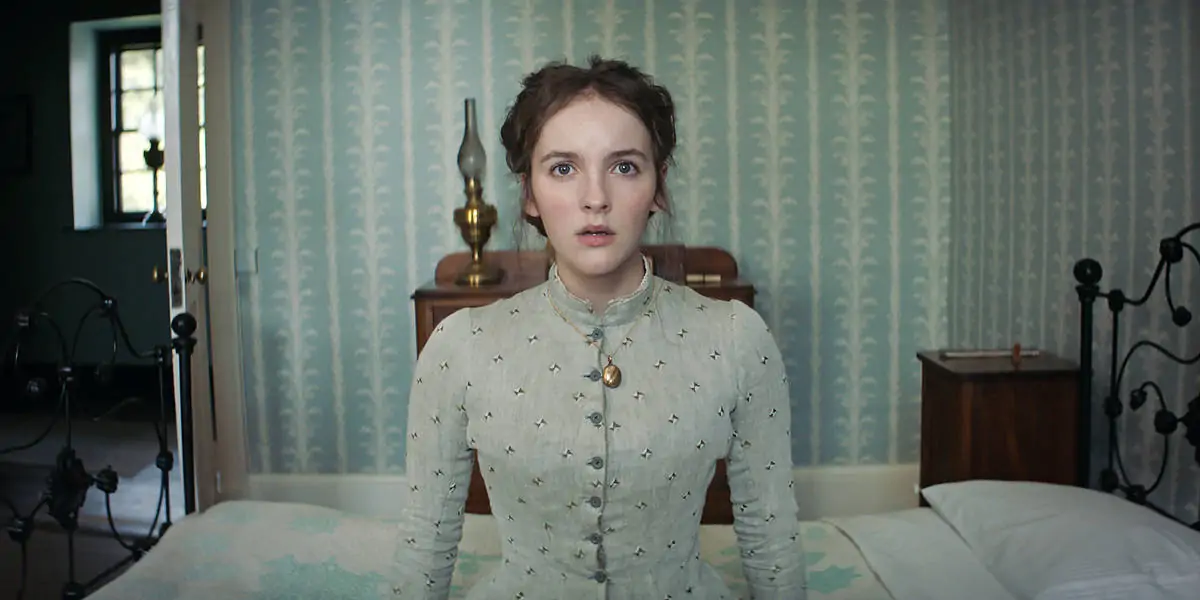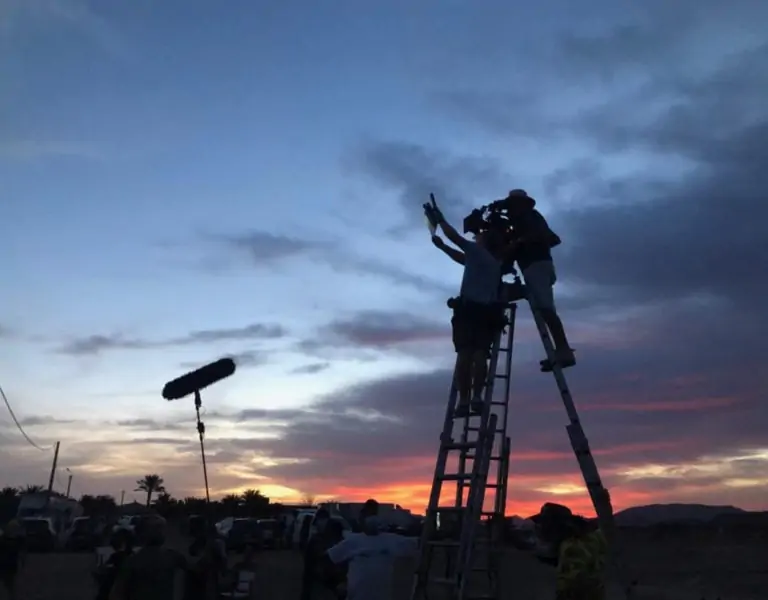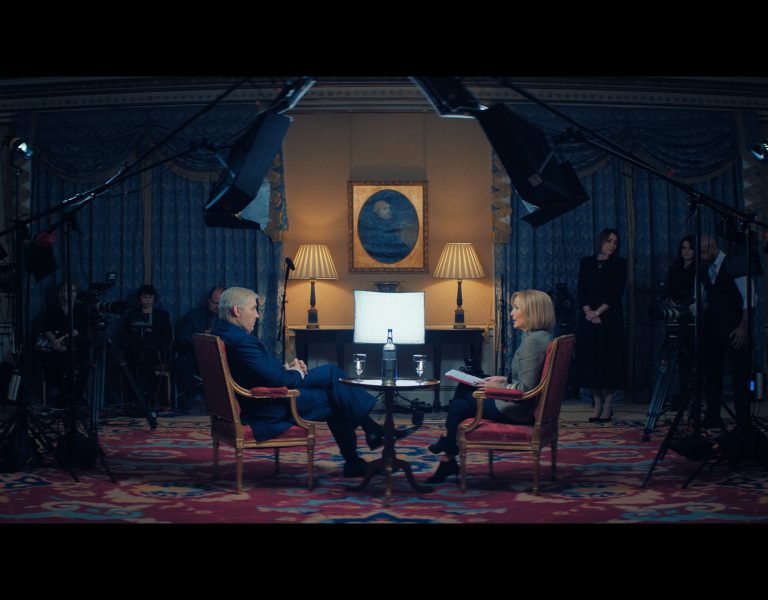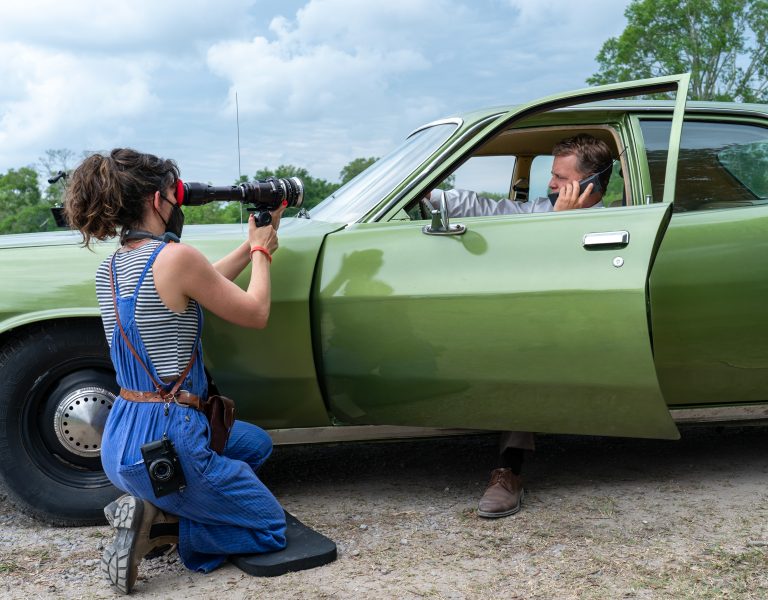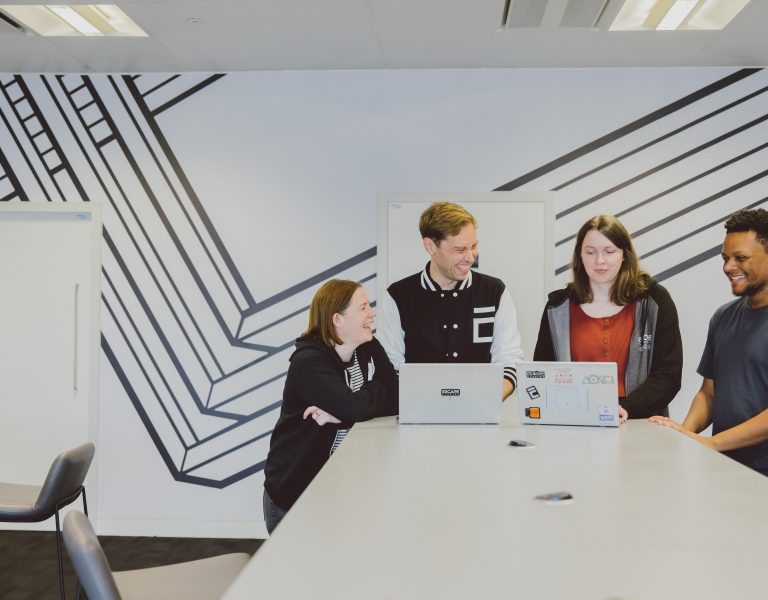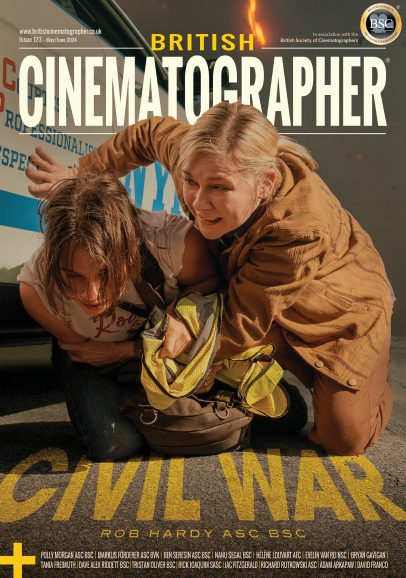MARRIAGE OF MINDS
Tasked with bringing Mr. & Mr. Smith to the small screen, the show’s three cinematographers reflect on crafting a stirring and standalone visual language for the spy thriller.
Inspired by Doug Liman’s 2005 romantic spy thriller starring Brad Pitt and Angelina Jolie, Mr. & Mrs. Smith marks a reunion for many of those who worked on the popular comedy-drama TV show Atlanta. Alongside creator-star Donald Glover and producer/director Hiro Murai, this slick and stylish Prime Video series reunites the talents of cinematographers Christian Sprenger ASC, Stephen Murphy BSC ISC and chief lighting technician Cody Jacobs, who also took on DP duties across one of the eight episodes.

With Mr. & Mrs. Smith co-created by Francesca Sloane, the show echoes the format of the Liman movie, as two strangers (Glover and Maya Erskine), pretending to be married couple John and Jane Smith, are sent on espionage missions. “It’s definitely a show about a couple, about a relationship,” explains the Irish-born Murphy. “[It shows] the formation of a relationship, how you fall in love with somebody. Then the cracks start to show and then eventually, maybe, it disintegrates a little bit. It’s definitely about that human side of things, rather than about any set pieces.”
With a six-month production schedule spread across America and Europe, Mr. & Mrs. Smith required considerable planning – with Sprenger filming episodes one, two, five and season finale eight, Murphy shooting episodes three, six and seven and Jacobs manning episode four, which Sprenger directed. Other directors on the show included Glover, Karena Evans and Amy Seimetz. But it was Glover and Sloane that set the tone, along with Murai, who helmed the first two episodes. “By and large we wanted to avoid borrowing too hard from the film,” says Sprenger. “Stylistically and visually, we wanted this show to exist in its own [right].”
During the pre-production phase, references were pulled from classic movies from the 1970s. “As Hiro and I were constructing the visual language, we were quite fond of films such as The American Friend, Mean Streets, The French Connection [and] Three Days of the Condor,” explains Sprenger. “There were a lot of conversations in prep that we wanted to emulate ’70s spy/crime cinema but also how we didn’t want the show to come off as a straight spy/action series. We wanted the audience to lose themselves in the narrative of John and Jane’s awkward relationship in the way one does with a great Wong Kar-wai film or Woody Allen and then suddenly be thrown back into the action world.”

Looks and LUTs
Sprenger was also responsible for choosing the camera to shoot the show on. After much consideration, he went for the ARRI Alexa Mini LF. “Given the genre and era that we were referencing, there was a long discussion in prep about shooting the series on film or printing to film at the end,” he explains. The cinematographer shot test footage of both the digital Alexa Mini LF and the 35mm Kodak 5219, working alongside Harbor Picture Company colourist Damien Van Der Cruyssen to present side-by-side comparisons.
“Damien and the colour science team at Harbor came up with a really incredible in-camera LUT and a post recipe to emulate what we were really liking about the 5219 look we had created,” adds Sprenger. In the end, it was decided the Alexa Mini LF was the right choice. “The Alexa has a fantastic dynamic range,” comments Murphy, who was familiar with the camera already. “It’s a relatively small body. And the way we were [going to] underexpose the images for that ’70s style we were going for…it handles that really well.”
As Jacobs notes, the show’s 1st AC Craig Pressgrove “outfitted the camera in such a way to make it easy to use things like small remote heads and other equipment that were necessary in some of our cramped New York and Italian locations”. Meanwhile, Moviecam Primes were the go-to lens choice, although there were moments that others were selected. “One of my New York-set eps needed a lot of telephoto work,” explains Murphy, “so I used longer zooms like the Angénieux 35-435mm or the Century 150-600mm with extenders.”

Shooting with the 2:1 aspect ratio, frequent use was also made of Tiffen Smoque filters too. “I’ve been using those for years,” says Murphy. “I’ve had Tiffen make me custom-strength versions of those many, many years ago, but Christian was using those on episode one. And so that gave me free rein to have them in my episodes as well. It gives you a little bit of texture, as if you’ve added a bit of haze to the room. And that softens the colours as well a little bit. It just helps steer the digital image towards a more filmic world.”
Other crucial equipment included a Steadicam, operated by Michael Fuchs, and a Ronin – both deployed throughout the season. “Early on it was clear to us that the base language of the show wanted to be calm and controlled using dollies and Steadicam,” explains Sprenger.
Still, in both action and dialogue scenes, there were moments where it felt more authentic to be on a wider lens, shooting handheld. “We tried to just pay attention to how scenes were feeling,” he continues, “and there were several times where Hiro and I would cut, after the first take, and look at each other and both say ‘handheld’?”
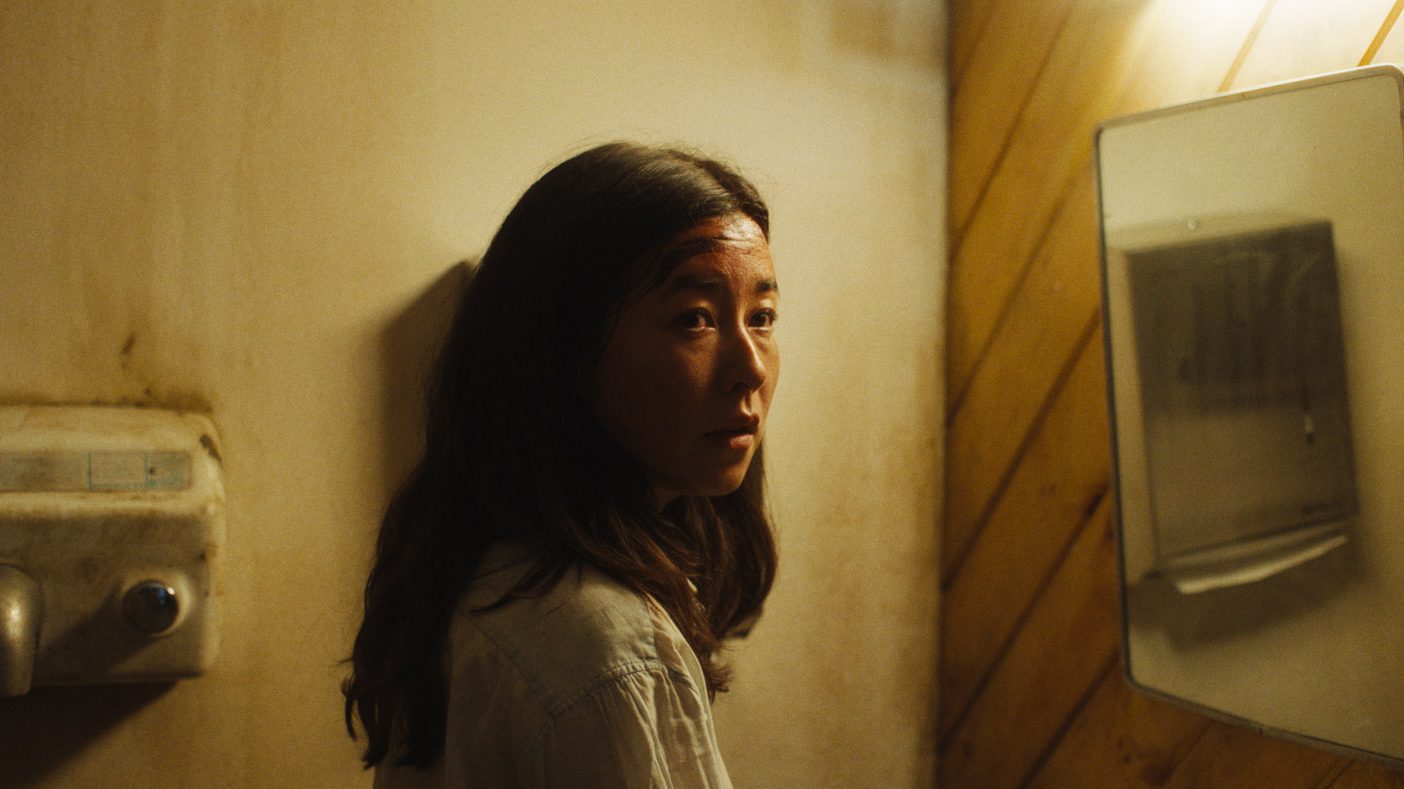
Logistics and efficiency
When it came to lighting the show, various tools were deployed. “We weren’t dogmatic about the type of fixtures we wanted to use, and let logistics and efficiency drive our choices,” says Jacobs. “The entire series was a mix of traditional tungsten and HMI units as well as more modern LED and moving light fixtures.” Among those used were LED lights from the Creamsource Vortex line, LiteGear panels and ribbons, and ARRI SkyPanels, all of which were used to illuminate the show’s main set – the Smiths’ townhouse. ARRI T24s, T12s, and a mix of SolaFrame HyBeam lights were also used to give contrast to each “floor” of the luxury residence.
More mobile elements were also used. “My favourite lighting tool in New York became the Lightsock,” adds Murphy. “It’s like an inflatable tube that wraps around the Astera Titan Tube.” Murphy calls it the “modern equivalent” of the “covered wagon” – the old-school baton strip with multiple tungsten bulbs. “The Lightsock is like an LED tube version of that. It’s super-light. It means I can drop it on the ground, I can rig it to the ceiling, stick it to the walls and regardless of location, it fits in everywhere. So I was loving that. I’ve used them on every job I’ve done since then.”
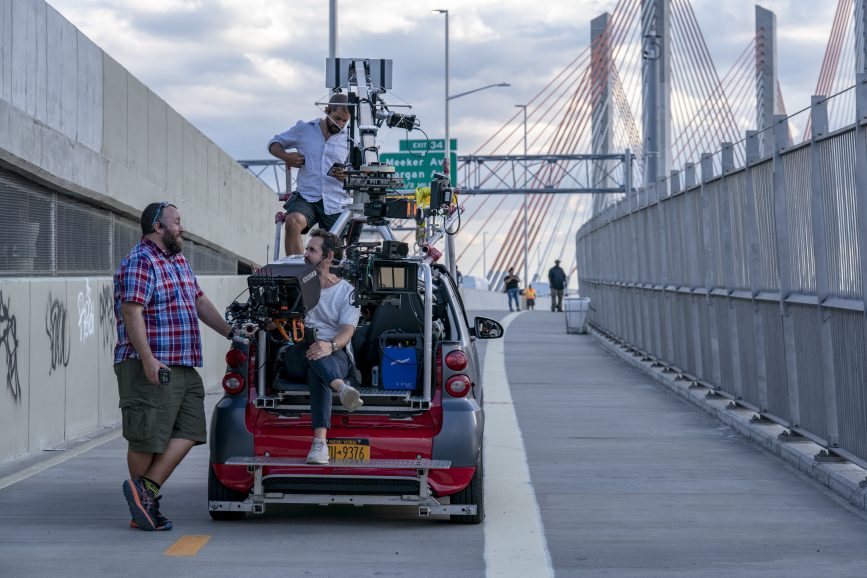
For Jacobs’ episode, as the Smiths come to meet another pair of spies working for their agency, he was grateful for the input of Mexican gaffer Vladimir Martínez. “The whole photographic journey of the episode, as well as in many ways its climax, leads John and Jane into this completely pitch-black jungle shack,” he says. “We needed something that could give us a tiny amount of separation on the characters while keeping the floor clear for the actors and leaving the image mostly in silhouette. Vladimir suggested we bounce some LED Leko units into 1×1-sized CRLS reflectors rigged into the ceiling of our shack. It ended up being the perfect thing to keep that space dark while still giving a subtle amount of directional light to the actors.”
Another big challenge for Jacobs was working out how to light the nighttime scene set at a helipad, all shot at an actual Wall Street helicopter landing strip in Manhattan on the East River. “Because it is a functional heliport, we were severely limited on what could be pre-rigged and knowing that we would be using a working helicopter that had to be able to take off during the scene, the use of condors or the usual tools of night exterior lighting was ruled out by the narrow landing zone and the fact that we wanted to see 270 degrees of the New York skyline around us.”
Moreover, to help keep the energy up for the actors, the team aimed for minimal reset time in between set-ups. “We decided to use Chroma-Q Colour Force 72s laid on their sides along the entire perimeter of the landing zone,” Jacobs continues. “These fixtures blended in as industrial landing strip lights and were heavy enough to withstand the prop wash from our hero helicopter taking off and landing. We dialled them up and down in intensity depending on the camera angle, and beyond that we had a few background pops provided by a mixture of traditional par cans, Creamsource Vortex 4s and 8s, and Astera AX5s.”

Stunts and speed
As much as Mr. & Mrs. Smith plays on the interaction of the characters and the fizzing dialogue, action scenes were plentiful. Episode two featured a rain-heavy car chase through Lower Manhattan. “That required heavy stunt rigs, multiple units shot in multiple cities, camera cars, live SFX, wet downs, VFX vehicles,” informs Sprenger. “But none of that compared to our Lake Como car chase shoot-out scene in episode five which had most of those same components but on an extremely narrow mountain road and now with our lead actor shooting and dodging bullets!” For that, Sprenger took charge of a drone unit, while Murphy shot second unit.
Episode three, meanwhile, takes the Smiths to the Dolomites in Italy, a snowy, mountainous environment which presented its own unique set of problems to solve. “I had shot a documentary in heavy snow in the Alps, so I had some sense of how tricky it was going to be,” says Murphy. Everything from maintaining camera battery life (severely affected by the cold) to working at high altitude had to be considered. “You can’t just run over here and lay 50 feet of track because you’re dealing with the snow and with the thinner oxygen,” he adds. “So it affects your way of thinking.”

Despite multiple DPs and directors filming episodes, a visual consistency was found, and Jacobs gives due credit to the team behind him, Sprenger and Murphy. “It was a huge pleasure to work with some truly exceptional fellow gaffers all over the world. George Selden in New York, Elvis Pasqual in Italy and Vladimir Martínez in Mexico. Our lighting desk programmers in New York and Italy, Mike Arisohn and Abdellatif Ouarrak respectively, were also a huge asset in the look of the series. And our rigging gaffers in New York and Italy, Casey Ford and Andrea Rostellato, were incredible, not to mention our stellar New York-based key grip Brendan Lowry and his entire team.”
At the heart were the show’s co-creators Sloane and Glover, who were both always on set but placed “a lot of trust” in the team. “We really were given a huge amount of freedom to bring our sensibilities to the project,” adds Murphy. “The main thing Donald would talk about was that it was important to remember that each episode was about the relationship between the two main characters. That was the focus of the storytelling.” Unlike John and Jane Smith, you might say, it sounds like the perfect marriage.
Mr. & Mrs. Smith is available on Prime Video.

